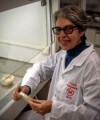Actualidad
Natural Substances for Controlling Soft Rot in Sweet Potatoes
The application of natural substances such as 2-methylbutanoic acid, isobutyric acid, perillaldehyde, and salicylaldehyde controls Rhizopus stolonifer, the causative agent of postharvest soft rot in sweet potatoes
Sweet potatoes (Ipomoea batatas L. Lam, Convolvulaceae family) are cultivated worldwide in tropical, subtropical, and temperate regions. They have tuberous roots rich in proteins, fibers, minerals (iron, calcium, magnesium, and potassium), vitamins, polyphenols, flavonoids, and carotenoids among other nutraceuticals. However, these roots have a high moisture content (50–80%) and thin skin, making them susceptible to mechanical damage and microbial attacks during handling and postharvest storage, leading to their decomposition.
Rhizopus stolonifer, one of the most destructive pathogens
Fungi are typically the main pathogens causing rot in sweet potatoes, and the annual yield loss is significant. Rhizopus stolonifer (Mucoromycota) is one of the most destructive, causing massive loss after harvest.
R. stolonifer is also a significant pathogen of many other crops, such as peaches, strawberries, and tomatoes.
Several synthetic fungicides are conventionally used to control this deterioration, but R. stolonifer's resistance to these substances has increased dramatically in recent years due to widespread long-term use.
Furthermore, their application can lead to environmental contamination, accumulation of harmful compounds, etc. Therefore, it is vital to seek effective and environmentally friendly antifungal agents to control postharvest fungal diseases in these vegetables.
Volatile organic compounds for disease biocontrol
Many natural volatile organic compounds are safe and can protect agricultural products from diseases, emerging as a suitable alternative in postharvest disease biocontrol. These metabolites can increase the permeability of the cell membrane, alter mitochondrial function and morphology, induce excessive reactive oxygen species (ROS) production leading to pathogen cell dysfunction and death.
The volatile compounds 2-methylbutanoic acid and isobutyric acid, produced by bacteria of the genus Bacillus, can effectively inhibit the growth of various fungi such as Alternaria alternata and Colletotrichum lindemuthianum.
Perillaldehyde is a monoterpene compound extracted from the leaves of perilla plants of the Lamiaceae family and exhibits strong antifungal activities against Aspergillus niger, Ceratocystis fimbriata, Fusarium solani, Aspergillus flavus, Aspergillus oryzae, and also Alternaria alternata.
Salicylaldehyde is present in buckwheat seeds and has antifungal and antimycotoxigenic properties, making its use in food considered safe.
Effectiveness of volatile organic compounds on R. stolonifer
A recent study examined the inhibitory effects of these natural compounds at different concentrations on the mycelial growth and spore germination of R. stolonifer, and evaluated their effects on its cell membrane and mitochondrial structure and function.
It was found that they completely inhibit hyphal development and spore germination, destroying the integrity of the cell membrane with the consequent leakage of nucleic acids and proteins from R. stolonifer.
It was also observed that salicylaldehyde increases the activities of enzymes conferring disease resistance in sweet potatoes during 15 days of storage.
Therefore, all these substances may be a promising alternative to fungicides in postharvest preservation.
Source
Li, L.; Sun, H. N.; Zhang, M.; Hua, T. (2024). Exploring the potential in postharvest preservation of sweet potato: 2-methylbutanoic acid, isobutyric acid, perillaldehyde and salicylaldehyde, to control Rhizopus stolonifer Postharvest Biology and Technology, 210: 112785.
Image:
https://djgnicevs.pics/product_details/1033330.html Accessed on 17/04/2024













